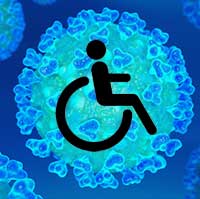COVID-19 - Disabled Person with Coronavirus
Symptoms after Receiving Subsequent Vaccine Doses

I contracted COVID-19 at the beginning of December 2020. Since the Social Welfare Home where I live had been closed for over two months (with a ban on visits and leaving the facility), I was infected by a staff member. I was not the first person to become infected. The situation came to light when one of the residents felt unwell, was hospitalized, and tested positive for the coronavirus. Unfortunately, this resident passed away, along with ten other residents shortly thereafter.
The first symptoms of SARS-CoV-2 were very mild for me. For two to three days, I experienced a mild fever that would come and go. We were tested on the third day after the infection was detected in our facility, so I dismissed these symptoms. It wasn't until the test results came back that I realized the low-grade fevers were not coincidental.
The following days became increasingly difficult. My afternoon temperature hovered around 38 degrees Celsius, and I felt increasingly fatigued. The worst days were the 7th and 8th, when lifting my head off the pillow felt like a significant effort. Every few hours, I would lose and regain my sense of taste and smell. During that time, my oxygen saturation even dropped to 75 percent for several hours. I started to worry a bit that I would have to go to the hospital, but soon my oxygen levels returned to above 90 percent, and the terrifying vision of being at the mercy of the Polish healthcare system receded.
The next two days with COVID-19 were marked by temperatures up to 38 degrees and considerable weakness. It was somewhat frustrating that after so many days, the coronavirus still plagued me, even though I knew it usually lasts around 10 days. The exhaustion from the illness and the longing for recovery unfortunately clouded my rational thinking.
On the 11th day, I woke up feeling transformed. I felt healthy and full of strength. However, the next few days occasionally reminded me of my recent battle with SARS-CoV-2 through slight weakness, but after three weeks, everything returned to normal, and I began to feel like I did before the illness.
Before the infection, I had wondered how my body would cope with the coronavirus. I had not received any information regarding individuals with spinal cord injuries at the cervical level and their experiences with COVID-19. I still don't know if wheelchair users are classified as individuals with comorbidities, but through my own experience, I want to show that it is possible to undergo this infection relatively decently. Despite the challenging moments, I appreciate the fact that I avoided headaches, shortness of breath, and, above all, any lasting health impairments. If such an old tetraplegic with 23 years of experience without any medication can go through SARS-CoV-2 relatively mildly, then there is no need to panic when the test turns out positive.
Wanting to minimize the chance of reinfection with the coronavirus, I got vaccinated with the Pfizer/BioNTech vaccine at the earliest opportunity. The first day passed without any undesirable symptoms. Exactly 24 hours later, a 7-centimeter rash appeared at the injection site (I don't know if it was painful, as I have no sensation in that area) and I developed a fever of 38.3 degrees, which dropped to 37.5 degrees after a few hours. In total, the elevated temperature lasted about 16 hours. After that time, I felt weak throughout the day. The following days passed without any side effects, and the rash disappeared after 5 days, so I can say that my body handled the first vaccine dose reasonably well.
I received the second vaccine dose, according to the manufacturer's recommendations, three weeks later. I hoped that this time there would be no undesirable symptoms. Unfortunately, about 21 hours later, I felt cold and experienced severe chills, and after another three hours, my temperature rose to 38.6 degrees. After taking one Codipar tablet, the fever quickly subsided, and I felt completely healthy. After receiving the second dose of the Pfizer/BioNTech vaccine, a 3-centimeter rash also appeared at the injection site, which was smaller than the first time and disappeared after four days.
I received the third dose of the so-called booster vaccine 8 months after being fully vaccinated. This was also the Pfizer/BioNTech vaccine. Similar to the first two cases, the next day I experienced a low-grade fever that lasted about 18 hours. I also had a small rash at the injection site, which disappeared after 7 days. In summary, I can state that the side effects from the third vaccine dose were milder but lasted longer compared to the previous two vaccinations against the coronavirus.
From the above description, it is evident that I did not escape the side effects of the COVID-19 vaccine. A few hours or even several hours of fever and a rash is a small price to pay for over ninety percent protection against severe illness from SARS-CoV-2. I recommend that anyone who is apprehensive about vaccination read reliable literature from reputable scientific institutes. It is clear from this literature that the coronavirus poses a significantly greater threat than the most advanced vaccine in the world, despite it being approved at record speed.

 PL
PL
 DE
DE
